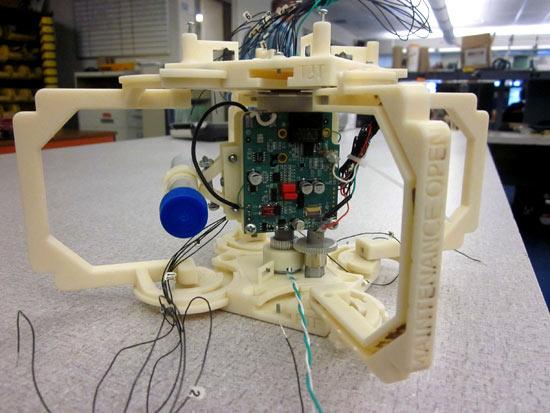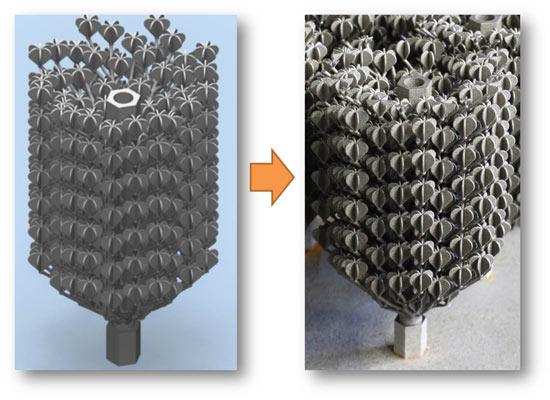 We love reporting on challenges like the annual Extreme Redesign 3D Printing Challenge from Stratasys as they serve several purposes—all positive and exciting.
We love reporting on challenges like the annual Extreme Redesign 3D Printing Challenge from Stratasys as they serve several purposes—all positive and exciting.
This annual 3D printing competition, now ongoing for over a decade, gives students the impetus and motivation for digging deep to create and innovate either an entirely new 3D printed design for a specific function or a redesign. With not only the reward of some great prizes looming if they win, students in secondary and post-secondary educational institutions have had the opportunity for a great learning experience.
The results are in now, after months of students working on their 3D printed designs in the fields of art and architecture, and engineering, with the results below. We’ve especially highlighted the first prize winners. To find out more about all the designs, click here.
Winners for Art and Architecture:
- First Place: Haya Alnibari and Ti Fu of Ryerson University in Toronto, Ontario, Canada – for the ‘Helico: Helix-Shaped Sharpener’
The 3D printed sharpener is meant to be not only easier to use due to its fluid mechanics, but more affordable to produce as well. Bearing an elegant, helix shape, the piece is a manual sharpener that “combines rotational force and linear force into a single helical movement, for simplifying the gritty act of sharpening a pencil in a simple fluid movement.”

First Place Art & Architecture: 3D printed Helico Helix-Shaped Sharpener, by Haya Alnibari and Ti Fu
- Second Place: Hou Shun Poh of the National University of Singapore – for ‘The Subspace’
- Third Place: Ashley Christensen and Lauren Aquilina of Michigan State University in East Lansing, Michigan – for ‘Prismatic’
Secondary Education Engineering:
- First Place: Thomas Vagnini of Tri-County Regional Vocational Technical High School in Franklin, Massachusetts – for ‘HUNCH 2015 Zero Gravity Scale’
Vagnini created what has the potential to be a very important 3D printed device for making measurements in space, with a zero-gravity scale which allows objects being pulled by centrifugal force to be attached to special force sensors for measuring. With over 30 hours in creating this device, the hope is that it will actually be used at the International Space Station (ISS).
- Second Place: Joshua Fuller of Tri-County Regional Vocational Technical High School in Franklin, Massachusetts – for ‘Zero Gravity Mixer’
- Third Place: Li Cheng Yu of Etobicoke Collegiate Institute in Toronto, Ontario, Canada – for ‘Socket Cube Concept’
Post-Secondary Engineering:
- First Place: Melanie Gralow and Lena Heemann at University of Bremen in Bremen, Germany – for ‘Cooling with Heat’
In ‘Cooling with Heat,’ students came up with an ingenious way to recycle the wasted energy from PC cooling units. “It was our goal to use the waste heat produced by the processor, convert it into electric energy, and make it available for applications like the cooling fan following the principle of ‘Energy Harvesting,’” relayed the students, who comment on how the heat spreading is a crucial indicator what is possible with 3D printing units.
- Second Place: Mahan Navabi and Mark Eyk of Ryerson University in Toronto, Ontario, Canada – for ‘Flex Key’
- Third Place: Alexandre Beznogov and Jossef Roozitalab Shirazi of Ryerson University in Toronto, Ontario, Canada – for ‘Ice Twist’
First-place winners in each category receive a $2,500 scholarship, while individuals taking second and third place receive a $1,000 scholarship. Instructors also receive prizes, with the first prize winners’ instructors each receiving a demo 3D printer to use for their classrooms for a limited time. New for this year’s contest, first-place secondary student winners also win a trip to a 2015 3D printing/additive manufacturing conference.
As an international community, we are all able to benefit from the incredible new innovations brought to us from these budding inventors—and I know I’d certainly like to see the Helico helix-shaped sharpeners in every school, offering kids a more fluid method of sharpening pencils, as well as offering a better look aesthetically.
With the central focus of the challenge being to improve on an existing and functional item, that means these winners, as well as the rest of the group, are adding something valuable to the world. Not only are their winning designs impressive and exciting to check out, the individuals behind the innovations are put into the spotlight and placed on the ‘promising innovators to watch out for’ list as we are sure to hear more from them.
Obviously, many students may not win but they gain experience and knowledge for trying next year. Designs must be creative and realistic, as well as mechanically sound. With nearly half a year to enter and work on items, this is a commitment to a major project, and to a major learning experience. We all have a chance to learn about interesting new designs–and to become further inspired ourselves.
Judges this year were:
- Tim Shinbara of the Association for Manufacturing Technology
- Patrick Ganno, a 3D printing industry veteran
- Leslie Langnau of Design World magazine
- Todd Grimm of T.A. Grimm and Associates
Over the eleven years that the contest has been running, Stratasys has awarded more than $100,000 in scholarships to innovative students.
What was your favorite design? Discuss in the 2015 Extreme Redesign 3D Printing Challenge forum thread over at 3DPB.com.
Subscribe to Our Email Newsletter
Stay up-to-date on all the latest news from the 3D printing industry and receive information and offers from third party vendors.
You May Also Like
Model No. Deploys Titan Pellet 3D Printers for Sustainable Furniture Production
Over the years, many designers have tried to create 3D printed polymer furniture. Early pioneers like Janne Kyttanen, Materialise’s MGX, and Joris Laarman have led the way with 3D printed...
3D Printing News Unpeeled: Recycling PLA, More Efficient Atomizing
Filamentive hopes to recycle your PLA if you’re in the UK and order over £500 worth of filament. Their partner 3D Printing Waste (3DPW) will turn the PLA into injection...
Lighting the Way with Potato Starch: Sustainable Polish ECO Lamps Use 3D Printing
Lighting that meets the essence of nature: this is the reality brought to life by ECO Lamps, which introduces a fresh perspective to sustainable lighting design using potato starch. These...
3D Printing News Unpeeled: 3D Printed Construction Standard, Sand Wall & Self Heating Microfluidics
ISO/ASTM Standard 52939:2023 has been released and it sets standards for QA for 3D Printed polymer, composite and cement buildings. This is most welcome since 3D printed construction is a...


































